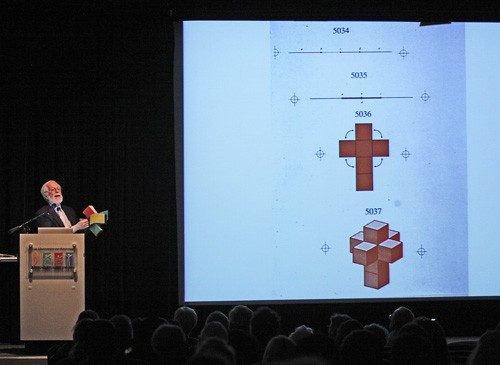Nestled in the back of Paradise Café sat Thomas Banchoff of Brown University. In town for the Daniel Bartlett Memorial Lecture series this past Monday, Banchoff agreed to speak with me before he left. His laptop erect before him, Banchoff turned to his wife with a puzzled look, as she attempted to show him how to call someone on Skype. For a man who has been doing research in mathematics since 1964, this was a rare moment of befuddlement.
After all, Banchoff has taught classes such as Combinatorial Topology and Hyperbolic Geometry. He isn’t exactly a slouch. As a geometery and mathematics professor, Banchoff studies geometric surfaces and shapes beyond even the fourth dimension. His wealth of knowledge seemed limitless. He casually noted that he dabbles in calculus to create shapes as if this was a typical leisure activity.
Here I was, someone who struggles to understand logarithms, sitting across the table from one of the most brilliant minds of geometric and spatial exploration of the past 50 years, and I don’t even own a calculator. As if Banchoff’s work and research was not daunting enough, he is also known for repeated consultations with famed surrealist, Salvador Dalí.
I was intimidated.
But as Banchoff spoke about his childhood, that feeling vanished. There was no deep mystery to the man’s love of math. He wasn’t a supervillain; He grew up loving shapes. He worked his way from two-dimensional diagrams to three-dimensional constructions. “”I liked to make models. I got excited when I heard about the fourth dimension from a comic book.”” He chuckled, “”I’m still trying to figure it out.””
After receiving his doctoral degree from University of California, Berkeley, Banchoff worked at Harvard and University of Amsterdam before settling at Brown University in 1967. He pioneered work in differential geometry, and in 1975, The Washington Post published an article about Banchoff’s work in its style section. The accompanying picture showed Banchoff holding up a plastic model inspired by Dalí’s painting “”Crucifixion (Corpus Hypercubus),”” housed in the New York Metropolitan Museum of Art. A few weeks later, Dalí’s representative telephoned Banchoff to set up a meeting.
Initially skeptical that it was Dalí who had contacted him, Banchoff found the request to be authentic when the two were introduced later that month. Dalí’s interest was to use technology to explore different perspectives. At the time, Dalí was working with holographic paintings and was attempting to move to stereoscopic paintings. He was looking for technical advice from Banchoff, who was making stereoscopic, animated films at the time. Banchoff explained that Dalí wanted to “”help people see things in new ways.””
Banchoff described their meetings as cordial and professional. “”We were both learning from each other.”” Over the years, the two would meet to exchange their newest work: Banchoff brought his films, Dalí brought his art. “”He was fascinated by the mathematics, the visual science and the forms.”” The two saw each other at least once each year over the next decade, as both men pursued images that could exist past the third dimension.
Dalí’s early work evoked the frustration of post-war surrealism, while his later work delved into the mathematical abstractions being explored worldwide. He was intensely fascinated by Rene Thom’s catastrophe theory. Banchoff recalled, “”Dalí would speak to Thom, then he would speak to me about visualization.””
In his later work, Dalí would use the catastrophe theory as inspiration to explore cubic equations, quadratic and fifth degree equations. His final painting, “”The Swallow’s Tail,”” uses the S-shapes of Thom’s theory to form everything from a Dalí mustache to a cello to a symbol for an integral in calculus to the overtly religious image of a chalice. The piece is housed in the Dalí Archives in Figueres, Spain.
Banchoff described Dalí as a wildly intelligent man. “”We could have conversations above the Scientific American level. We were talking about the interface between technology, mathematics and art. He knew what images fascinated him.”” Banchoff spoke of Dalí not as an idol but a respected colleague.
Only when prompted did Banchoff speak of Dalí’s renowned eccentricity. “”He had an outrageous persona. When we visited him in New York, he would hold court at the St. Regent’s Hotel cocktail lounge. He would speak to different people in French or Spanish or Catalan. They were flamboyant people in the art world or in the fashion world. It was a crazy spread. If you wanted to talk seriously, it was not out in the open.””
As the conversation came to a close, Banchoff mentioned his continuing research concerning the fourth dimension. Though in his seventies, he spoke with the vigor of a child. Once mystified by the fantastic realms of his comic books, he still wanted to explore them.
And for once in my life, I kind of did too.









